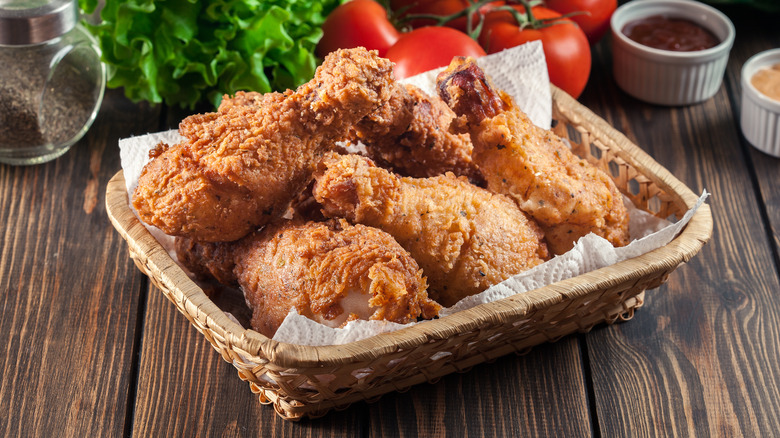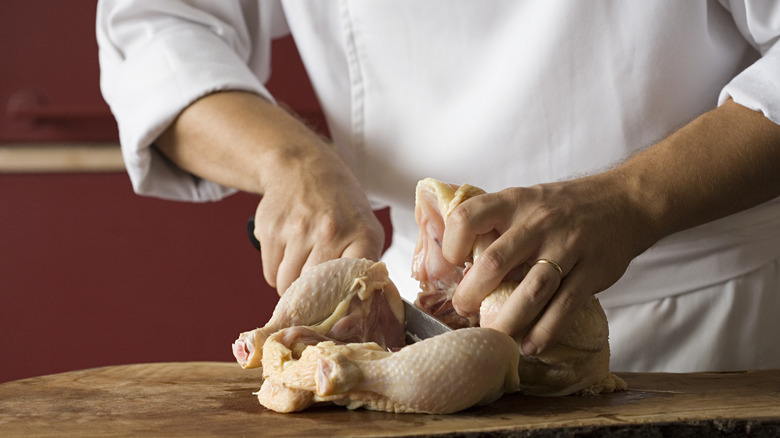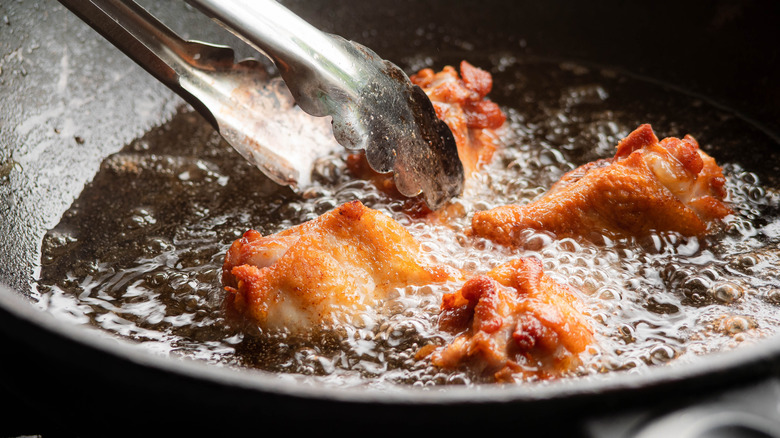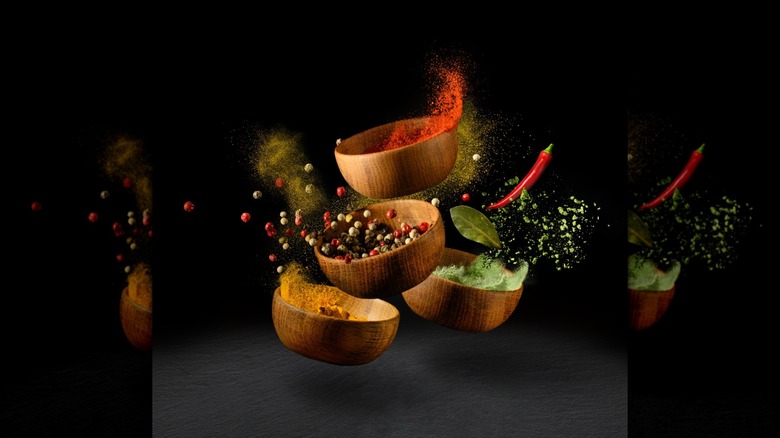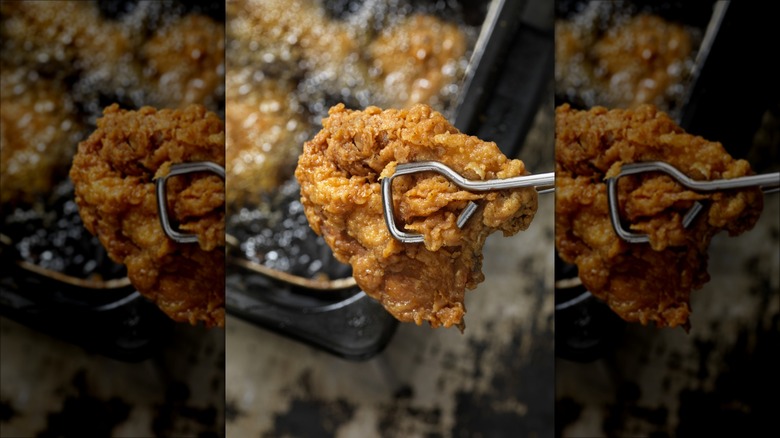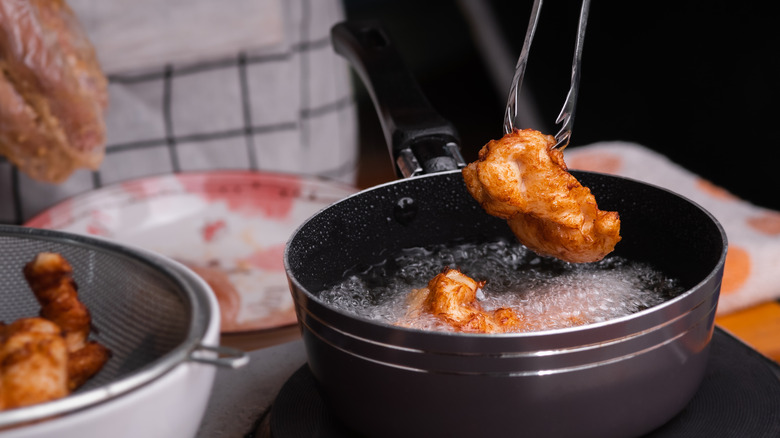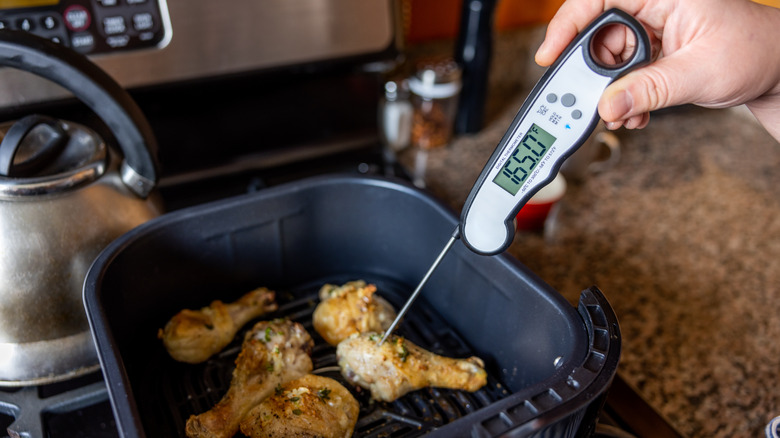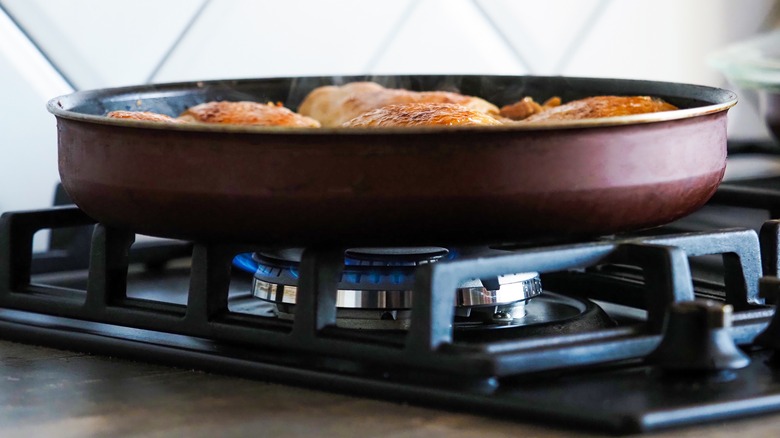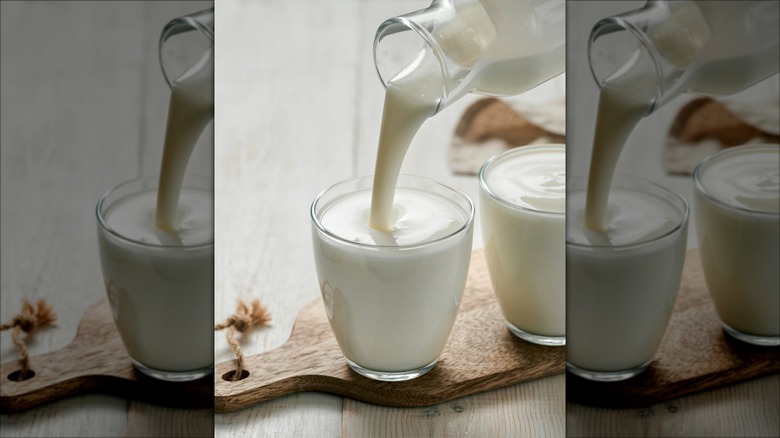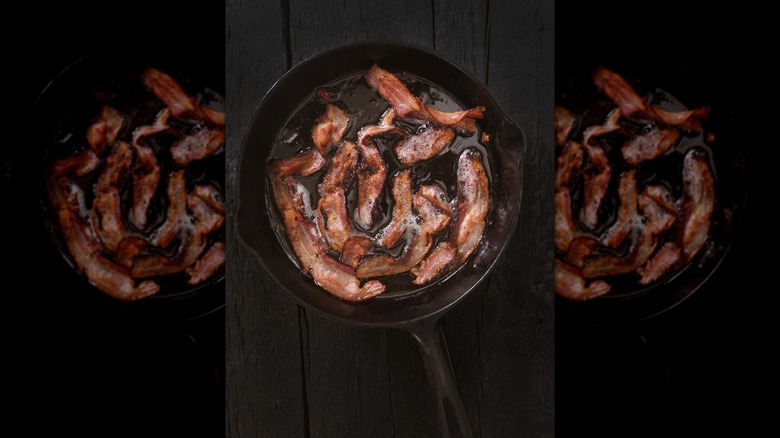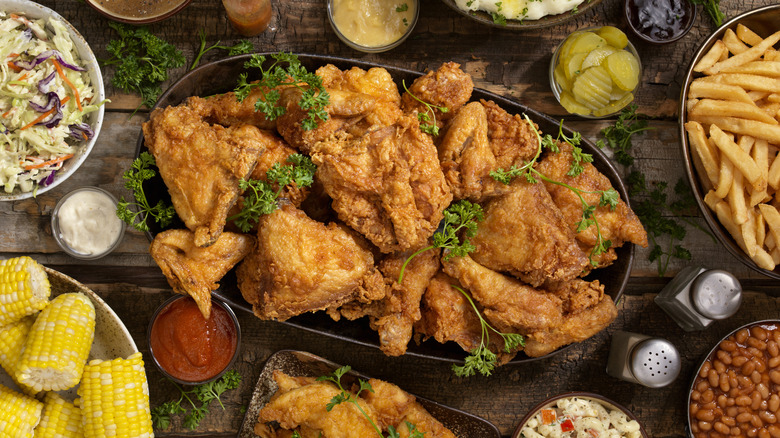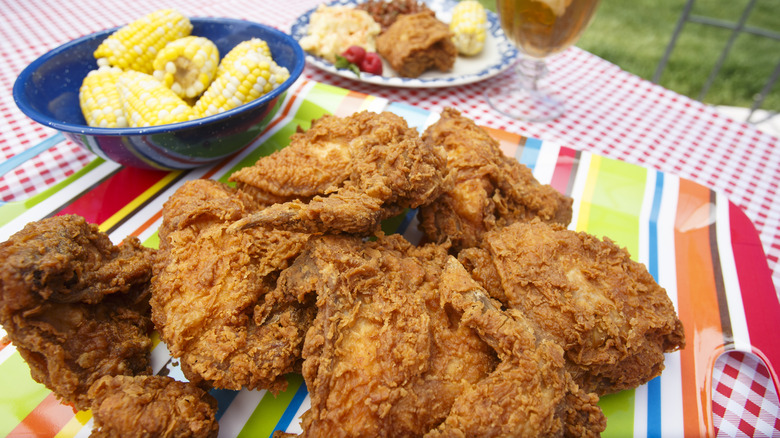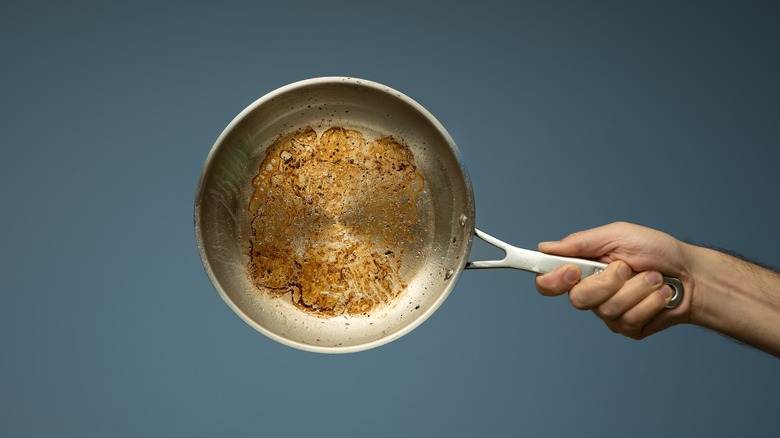Stop Making These Mistakes When Cooking Fried Chicken
Good homemade fried chicken is as much a feat of chemistry as it is cooking artistry. The ideal crisp exterior and juicy and savory interior come from specific chemical processes that take time for home cooks to master. While you don't need a chemistry degree to master these wonders of alchemical transformation, knowing how the chemistry works (and how to work the chemistry) goes a long way toward helping you to produce yummy fried chicken at home.
But good fried chicken is more than just chemistry. The types of ingredients you use, knowing how to use certain cooking tools, like thermometers or skillets, and even your reluctance to experiment a bit all come into play when you're frying up a batch of chicken. Not getting any of these elements right contributes to a less-than-satisfying plate of chicken. And this post would be remiss if it didn't mention the intimidation factor that sometimes accompanies trying to perfect a classic recipe like fried chicken. Standing in front of a bubbling cauldron of hot oil is difficult for the most experienced kitchen witch. How much is that the case for the novice when it comes time to create fried chicken wizardry?
All is not lost, however. If you'd like to tackle your fear of messing up homemade fried chicken, the tips in this piece will stop you from making the most common mistakes home cooks fall into when cheffing up this tried-and-true treat.
Starting with chicken straight from the fridge
When your nighttime dinner routine gets going, the temptation to pull your chicken straight from the fridge and plop it into the pan may overtake you. Resist this temptation if you want good, evenly-cooked fried chicken. Getting your chicken cooked inside and out and in balance doesn't require you to have epic balance in your Jedi-level cooking skills. No, the balance comes from starting with near-room temperature chicken (which is why it's important to know the temperature of your kitchen when you're cooking).
Skipping this step means chicken cooks unevenly. The exterior of your chicken takes on a nice doomsday-level crispness while the interior is practically still clucking. This happens because icebox cold chicken cools down the cooking oil, making everything in the pan have to work overtime. Uneven cooking results, which, incidentally, also opens up the possibility that harmful buggies will introduce themselves to you via your dinner. If you don't plan on inviting salmonella to supper, starting with room-temperature chicken helps to mitigate that because the bird gets cooked thoroughly.
Your chicken benefits from an aesthetic point of view, too. The coat of flour or batter covers the chicken more uniformly when you start with room-temperature chicken. Not only does it cook more evenly, it looks better. It crisps better, and if your fried chicken ain't crisp, you might as well put on the water to poach it.
Putting too much chicken in the pan at once
A lot of factors go into your decision to toss a few too many pieces of fried chicken into the skillet at once. The pan's too small. You've got 12 people to feed. You've convinced the people at Guinness World Records you can cook 300 pieces of chicken in two minutes. And so on. Whatever the reason, for the love of all things crispy, please stop. You'll get undercooked — or, at best, unevenly cooked, poached chicken — in the process.
Fried chicken requires a bit of wing room, so to speak, so that the heat doesn't linger underneath the bird in the pan. Steam rises if this happens and gets trapped under the pieces of chicken. Eventually, the poaching commences. Keeping the chicken separated encourages airflow and sets off the browning effects of the Maillard reaction, that chemical response in cooking that leaves behind golden crispy chicken in its wake. If you really do need to cook a large number of chicken pieces in one sitting, cook them up as normal and then use a foil tent or the oven to keep them toasty until dinner commences.
Getting the seasoning wrong
Conventional fried chicken wisdom tells you that it's best to add your seasonings to the flour before you fry the chicken, and admittedly, in some cases, with normal-ish seasonings, this is probably true. But you're not a normal-ish fried chicken cook. You're a food nerd, so you must use this seasoning food hack to make your fried chicken stand out.
Most home gourmands love to add copious amounts of their own special seasoning mix, like kosher salt, Hungarian paprika, garlic, and cayenne pepper, which they sprinkle on their marinated chicken. This seasoning mix usually gets added to the flour. That's not unusual.
However, adding the seasoning to the flour instead of adding it directly to the marinaded chicken may be a mistake in some instances. The reason for this is pretty logical. Certain seasonings, like paprika, burn during the cooking process if you add them to the flour. Putting the seasonings directly on the chicken and hiding them under the flour protects the delicate seasonings, like paprika. This seasoning method still allows you to season both the chicken and the flour but without the burning that could happen. Seasoning the flour can also waste a lot of seasoning, so you'll likely be saving in the long run.
Cooking before the oil is ready
Unless you fry chicken in an air fryer, some type of cooking oil will go into the mix. Whatever oil is chosen for the task must be warmed up. In fact, it won't be just warm. It'll be downright hot at 350 F. Don't start cooking until the oil reaches that temperature.
Because peanut and corn oils have smoke points of 450 F, they often are the go-to oils for frying chicken. Still, in all of this, the smoke point needs to stay in front of mind if you want the perfect chicken. If you cook the chicken on too high – let's say you use an oil that has a low smoke point - wisps of smoke will float above the pan like a disembodied Genie, but the taste won't be magical. It'll be funky and scorched.
On the flip side, oil that's too tepid, relatively speaking, results in greasy fried chicken because the chicken wallows in the grease without much cooking going on. the hot oil coats the batter with grease that soaks all the way through. It's one thing to joke about getting a greasy plate of diner fried chicken. It's another thing to have to eat one.
The best way to ensure that the oil's hot enough is a thermometer, particularly if you don't have years of cooking experience, which might allow you to know instinctively if the oil's ready. Don't risk it. Measure it just to be sure.
Flipping the chicken too infrequently
Evenly cooked chicken is chicken that you turn over and over repeatedly during the cooking process. It isn't more glamorous than that, though it's absolutely necessary for edible chicken. Edible chicken in this case refers to fried chicken that's cooked thoroughly on the inside but not burned on the outside. Acquiring this state of doneness requires work and can be time-intensive.
However, the method for achieving this is relatively simple, despite the time it requires you to stand in front of the stove. After the oil heats up, he puts the chicken into the oil and allows the chicken to brown for five or six minutes. Once it reaches a level of basic brownness on the outside, it needs to be turned and turned and turned again, every couple of minutes until the chicken gets cooked evenly inside and out. It's important to note, too, that light meat and dark meat cook at different rates, which means that even if you turned all the chicken in the pan at the same rate at the same time, some pieces, like the thighs, will take longer to cook regardless of how often you turn them. Keep this in mind to avoid unnecessary frustration as you cook and to ensure that pieces that don't take as long to cook don't get burned.
Spotty use of the cooking thermometer
Know what's delish? Fried chicken. Know what isn't? Salmonella. Or whatever. Pick your food poisoning. If you're like most food nerds, you already know that eating raw chicken pretty much guarantees spitting up not long after dinner is done. Fortunately, using a meat thermometer when you cook keeps microscopic buggies at bay, leaving you to enjoy that plate of fried chicken with no ill effects, except maybe needing to unbutton your britches after dinner.
Working with double thermometers is even better, however. With one thermometer, you'll get a read on the temperature of the oil. With the other, you see the chicken's temp. This allows you to get an accurate reading on each because the temperature read on the meat won't affect the temperature read on the oil, or vice versa.
When you measure the oil's temperature, immerse the thermometer into the oil until you reach 350 F. Don't start cooking before that temp reads on your thermometer, and don't let it get much higher than that once you reach it. As for the meat, poke the meat thermometer into the thickest and deepest part of the meat. Be careful to avoid the bone and the meat right on the bone, if there is any bone in that piece of meat. You'll get a false read, otherwise. Once the chicken hits 165 F, it's done.
Leaning too heavily on a fryer appliance for cooking
Some challenges, like keeping the oil's temperature consistent throughout the cooking process, present you, the skillet griller, with the biggest challenge when it comes to making fried chicken the old-fashioned way. This is one of the chief arguments for starting with a room-temperature bird. It doesn't put as much strain on the temperature in the pan as the stove, or you, try to regulate the heat in the oil.
Immerse the thermometer in the oil. You should have enough oil to cover the top of the chicken. Keeping the thermometer in the oil while you cook helps. Adjusting the temperature as the oil's temperature goes down – it will once you put the chicken in – helps.
Once seasoning and other prep are done, cook the dark meat first — the legs, thighs, and wings. Those cook longer, maybe 14 or 15 minutes. Cook the white meat for 12 to 15 minutes after the dark meat is done. Play it by ear. The size of the chicken affects the cooking time. Tenting the dark meat or stashing it in the oven keeps it warm while you cook the white meat. Remember to test the temp with a thermometer to ensure that the meat's cooked to 165 F before serving it.
Embracing only non-traditional chicken marinades
Tenderizing your chicken before you cook it makes for chicken that's moist, easy to eat, and delish, if you use the right marinade. There's no need to overthink what to use. A simple chicken marinade is often the best marinade for your homemade fried chicken, and fortunately, tradition has given up a hint for one of the simplest: buttermilk. You may not be a fan of buttermilk's taste straight out of the jug, but you'll probably like what a buttermilk marinade does for your fried chicken.
Buttermilk has acids in it that break down the meat, making it tender and tasty, even without adding any kind of other seasonings. Celebrity chef Alton Brown goes this route, sans seasonings. However, if you'd like to go to town and really make this a marinade, add ingredients like paprika, garlic, sriracha, the works.
Allow your chicken to sit in the marinade for at least two hours before cooking, though overnight is also okay. The longer it remains in the marinade, the more the meat tenderizes. But don't overdo it. The meat will eventually break down if it hangs out too long in the buttermilk. Add batter and seasonings, and do your other prep once it marinates.
Leaving out the secret ingredient: bacon grease
Flavor transfer is a thing when you're frying something in oil. That is to say if you first fry bacon and then fried chicken, your chicken will take on a bacon-y flavor. Bacon grease can become your fried chicken's unexpected ingredient if you know how to work with it. At 400 F, bacon has a smoke point that's nearly as high as peanut oil, which is 450 F. This means that if you'd like your fried chicken to have a bacon-y flavor, you can employ a peanut oil/bacon hybrid and still flavor up your chicken without having to use straight bacon grease to cook it in.
To do this, strain the extra bacon bits out of your bacon grease. Pour the peanut oil into the skillet and add in your leftover bacon grease. Heat it up, using a thermometer to ensure that the grease in the pan gets to 350 F, but not much more than that. Because bacon has a lower smoke point than peanut oil, it'll start smoking at a much quicker rate, and since you're mixing it with peanut oil, your peanut oil will, too. Keep an eye on the temperature as you cook, adjusting the heat so that it stays hot enough to cook the chicken but not so hot that the smoke point (and the smoke detector) is activated.
Frying only one kind of meat
Cooking for a crowd presents home chefs with a conundrum. What can they cook that satisfies everyone's different taste preferences? If said cook opts to cook a whole fried chicken, the conundrum is solved. Why? Cooking the whole chicken brings in both the light and dark meat, different-sized pieces, and different textures, ensuring there's something for everyone at the table.
Some home chefs avoid cooking any parts aside from the legs because the cooking times for the light and dark meat differ. However, it's possible to employ different cooking strategies to ensure every piece gets cooked properly, light or dark.
Some home gourmands cook the light and dark meats separately, while others position the chicken in the pan in such a way so as to ensure that all the pieces get cooked evenly. In the latter case, those home chefs position the meat in the pan's hotspot. This is in the middle of the pan, right above the burner. The pieces that need more cooking time, like the thighs, go there.
On a different but related note, home cooks who cut up their own chickens instead of buying parts usually save money because they're not paying a butcher to piece up the meat. It also gives them the bird's backbone, from which they can make stocks for winter soup.
Eating it too soon
Want your fried chicken to become the poultry equivalent of fine wine? Right after taking it out of the fryer, just let it sit for a few minutes before diving in. When you wait five to 10 minutes before eating it, the juices lurking deep within redistribute themselves and infuse your fried chicken with juiciness. Waiting to eat puts the kibosh on fried chicken that comes out as dry as the Mojave, despite the wellspring of juices that flowed out of the meat when you first cut into it. That juicy stream psyches you out, making you think that the fried chicken will be juicy when, in fact, all the juice worth speaking about drained out of the chicken and onto the plate once you cut it.
If you could see inside the chicken's interior, you'd see the proteins tightening up during the cooking process and then relaxing again once it's off the fire. When the proteins relax, the juice redistribution happens. When you don't wait, all the juices rush out, ending up in a pool below the meat. It's also the case that the cooking process ends once the bird's outside the frying pan, as counterintuitive as that might seem. It cooks the meat in the deepest part, raising the internal temperature by 10 degrees or more. So, resist the temptation to cut into the chicken straight out of the skillet and give it time to become the Le Poulet Blanc it desires to be.
Overlooking the stuff that makes it greasy
While a platter or two of greasy fried chicken probably equals a rite of passage for most novice cooks, there comes a point when greasy gets old. When that time comes, it's useful to remember that several factors lead to a case of the greasies when cooking fried chicken.
Ironically, one of the first reasons why fried chicken turns out greasy is the excess moisture on the chicken. The moisture creates steam in the pan and prevents the Maillard reaction from occurring. The moisture lowers the oil's temperature, which puts the kibosh on the crispy, golden fried chicken you were aiming for. This, in turn, allows the grease to soak into the flour coating, turning the chicken greasy instead of crispy. Aside from patting the chicken dry with a paper towel during prep to prevent excess moisture, it's possible to add ingredients, like corn starch, to the flour mixture to soak up extra moisture.
That's the second reason you get greasy chicken, by the way. You use the wrong coating. Flour alone may work fine in many instances, but adding corn starch gives you extra insurance against the grease spill by preventing steamed chicken instead of fried. Finally, not giving the chicken elbow room in the pan is another cause of greasiness. This condition – otherwise known as overcrowding – also causes steam in the pan. This soaks the flour coating and encourages the oil to seep into the wet flour.
